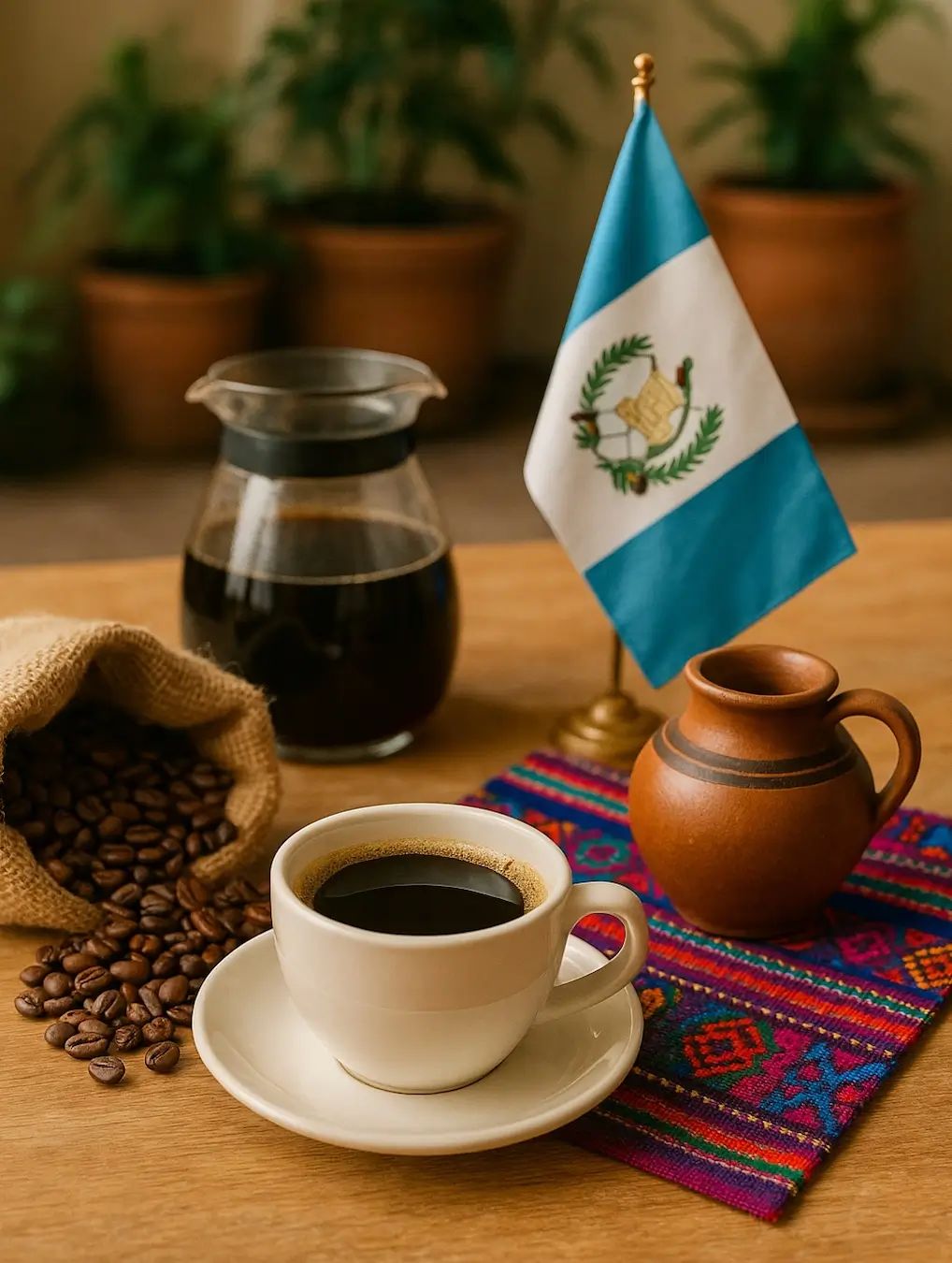Guatemalan coffee has a worldwide reputation. People who love coffee often seek it out. It offers a distinct taste, rich and complex. This coffee blends unique geography with careful growing practices. The result is a memorable cup. From its bright acidity to its subtle scent, Guatemalan coffee delivers a premium experience. You will notice this if you enjoy fine Arabica coffee.
What makes Guatemalan coffee unique?
Guatemalan coffee stands out. It comes from special environmental factors and dedicated farming. The country has diverse landscapes. Towering volcanoes and varied altitudes provide an ideal place to grow coffee beans. These elements create the coffee’s unique taste and high quality.
Signature flavor profile
Guatemalan coffee offers a rich, intricate taste. It’s a delightful sensory experience. You’ll often find notes from bittersweet to sweet chocolate. Smooth caramel undertones appear too. Bright citrus and subtle floral hints complement the taste. You might also notice nuts, like almonds or walnuts, adding depth. Some regions even have delicate notes of apples and berries.
This coffee usually has a medium to full body. It feels silky or creamy in your mouth. You will taste a bright, balanced acidity. This makes for a lively, refreshing flavor that won’t overwhelm you. The aroma is also inviting. It blends citrus and sweet floral notes, promising a delightful cup before you even take a sip.
Ideal growing conditions
Guatemalan coffee thrives because of the country’s geology and climate. Nutrient-rich volcanic soil plays a key role. It gives essential minerals to the coffee plants. Many farms sit at high altitudes. This slows down bean growth. Slower growth concentrates flavors and makes beans denser.
Diverse microclimates add to unique flavor differences. Each region develops its own distinct traits. Farmers use artisanal practices, passed down through generations. They meticulously care for the plants and cherries. These factors, plus volcanic ash and pumice, create a perfect environment for world-class coffee beans.
Renowned coffee-producing regions
Guatemala’s famous coffee regions each give distinct qualities to the country’s coffee. Areas like Antigua, Acatenango Valley, and Huehuetenango have unique climates, soils, and altitudes. Each region shapes its coffee beans’ flavor and quality in a very individual way.
Guatemalan coffee regions at a glance
| Region | Key Characteristics | Flavor Notes |
|---|---|---|
| Antigua | Classic profile, volcanic valley, low humidity, cool nights, shade-grown | Chocolate, nuts, citrus |
| Acatenango Valley | Volcanic intensity, steep slopes, high elevations, ocean breezes, sun-drying | Vibrant acidity, fruit-like characteristics |
| Huehuetenango | Highlands, highest and driest non-volcanic region, dry hot wind, slow maturation | Bright acidity, delicate floral, distinct fruity, velvety mouthfeel |
Antigua: Classic Guatemalan profile
Antigua is Guatemala’s most famous coffee region. It offers a classic Guatemalan coffee profile. Many connoisseurs seek it out. This region sits in a beautiful volcanic valley. Three majestic volcanoes surround it: Agua, Fuego, and Acatenango. This unique geography provides rich volcanic soil. Mineral deposits from volcanic activity constantly enrich the soil.
Antigua’s climate is ideal. It has low humidity, plenty of sunlight, and cool nights. Volcanic ash gives essential minerals to the soil. Volcanic pumice helps soil hold moisture, even with little rain. Farmers also use dense shade. This protects coffee plants from frost. It also promotes slow bean maturation. Antigua coffee typically has a medium to full body. You’ll taste vibrant acidity and strong notes of chocolate, nuts, and citrus.
Acatenango Valley: Volcanic intensity
Acatenango Valley sits next to Antigua. It offers a different, yet equally impressive Guatemalan coffee. Volcanic activity marks this region. Volcanic soil here gets constant enrichment from Fuego volcano’s eruptions. Farmers grow coffee under dense shade. They plant on steep slopes at high elevations—up to about 2,000 meters.
The region gets temperate ocean breezes and distinct seasons. This allows for sun-drying the coffee beans. Acatenango coffees show vibrant acidity and pleasant fruit-like characteristics. They have a beautifully balanced structure. The unique microclimate, with its volcanic activity and high elevation, gives the coffee a distinct, complex flavor. Each bean carries the essence of its dramatic growing environment.
Huehuetenango: The Highlands’ distinctive brew
Huehuetenango sits in western Guatemala’s highlands. It is the country’s highest and driest non-volcanic coffee region. This unique geography sets its Guatemalan coffee apart from volcanic areas. High altitude benefits the area. A consistent dry, hot wind comes from Mexico’s Tehuantepec plain.
This wind slows coffee bean growth. This creates a more complex and refined flavor. Huehuetenango coffees are famous for their bright acidity. You will find delicate floral notes and distinct fruity notes. They also have a remarkably velvety feel in your mouth. This unique mix of environmental factors creates an exceptional and nuanced cup.
Impact of terroir
Terroir deeply impacts Guatemalan coffee. It defines each region’s coffee traits. Altitude matters. It influences bean density and flavor. Soil composition also plays a role. Volcanic mineral richness, found in many areas, gives essential nutrients to coffee plants.
Climate, like temperature and humidity, directly affects cherry growth and processing. Shade cultivation is common. It helps regulate bean development and protects plants from stress. These factors work together. They determine the unique flavor, acidity, body, and aroma that set apart each regional Guatemalan coffee.
Primary coffee varieties
Farmers in Guatemala mainly grow exceptional Arabica coffee. This forms the core of the country’s famous production. They carefully select and grow these varieties. This ensures top quality and diverse flavors. This focus on Arabica has made Guatemala a leader in specialty coffee.
Traditional Arabica varieties
Traditional Arabica varieties form the base of Guatemalan coffee. People value them for their established qualities and diverse traits. Each variety adds something unique to the country’s rich coffee heritage.
- Bourbon: People highly value this variety for its sweet, complex cup, and it usually gives a high-quality coffee,
- Caturra: This is a natural mutation of Typica. We value Caturra for its bright acidity and balanced medium body,
- Catuai: This hybrid variety is known for its strong productivity and balanced flavor,
- Pache: Guatemalans developed Pache locally. It adapts well to different growing conditions. It tends to produce a full-bodied coffee,
- Typica: As one of the oldest Arabica varieties, Typica has a nuanced flavor and delicate aroma. It offers a classic coffee taste,
- Maragogipe: This unique Arabica mutation produces exceptionally large beans, often called “elephant beans.” It offers a distinct flavor profile.
Newer and rust-resistant varieties
Newer Guatemalan coffee varieties are becoming popular. They offer unique cup profiles and stronger resilience. Specialty coffee lovers seek varieties like Gesha, Pacamara, and Maracaturra. They love their distinct, often exquisite, flavors. These new options add to Guatemala’s diverse coffee range.
Rust-resistant hybrids, like Catimor and Sarchimor, are now crucial for Guatemala’s coffee industry. Growers developed these varieties to fight widespread coffee leaf rust outbreaks. The rust posed a major threat to crops. About 20% of Guatemala’s coffee now uses these tough hybrids. This shows the industry’s commitment to sustainability. It also shows how they adapt to farming challenges.
Common coffee processing methods
Most Guatemalan coffee uses the fully washed (wet) method. Farmers prefer it because it produces clean, consistent flavors. This method dominates. But some natural (dry) and honey processing also happen. These happen under specific, careful conditions. The processing method greatly changes the final taste and quality of the Guatemalan coffee bean.
Dominance of the washed method
The fully washed (wet) method dominates coffee processing in Guatemala. Farmers favor it for its consistent quality. This careful process removes all fruit from coffee beans before drying. It leaves a clean mucilage layer. Then, workers wash this layer away. This method typically gives clean, crisp, often more acidic flavors. It lets the bean’s natural qualities stand out.
Guatemala’s high humidity makes other methods difficult. It increases the risk of over-fermentation and spoilage. The washed method handles these challenges well. It ensures superior coffee quality. It remains the top choice. It reliably produces premium Guatemalan coffee with bright, pure flavors. This preference shows the Guatemalan coffee industry’s dedication to quality control.
Natural and honey processing methods
The fully washed method is most common. However, some farmers use natural and honey processing for Guatemalan coffee. These methods are less common. Natural processing dries the whole coffee cherry. Honey processing leaves part of the mucilage on the bean while drying. These methods usually make coffee sweeter and fuller-bodied. But they need very careful conditions.
Guatemala’s high humidity often makes these alternative methods hard. It increases the risk of defects from too much moisture. So, farmers produce natural and honey processed Guatemalan coffee beans in smaller amounts. Often, specialty producers do this. They take an artisanal approach to coffee processing. This gives unique flavors when done perfectly.
A brief history of cultivation
The history of Guatemalan coffee cultivation shows its journey. It went from a small curiosity to a key part of the national economy. Jesuit missionaries brought coffee to the country in the mid-1700s. It first grew as a decorative plant in monastery gardens. But its potential as a commercial crop soon became clear. This set the stage for major farming development.
Early introduction and growth
Jesuit missionaries brought Guatemalan coffee to the region in the mid-1700s. These plants first decorated monastery gardens. People valued them for their looks, not for selling. But good climate and rich volcanic soil soon showed coffee could grow on a large scale.
Coffee farming took off in the 19th century. It quickly became a major export. Large European landowners saw profits. They invested heavily in the new coffee industry. This time marked a crucial change. Coffee became a driving force for Guatemala’s economy. It cemented its place in farming history.
Economic significance and resilience
Guatemalan coffee deeply impacts the economy. It consistently helps the nation’s finances. By the 19th century, coffee production boomed. It became the main force for Guatemala’s economic stability and growth. The industry drew international attention. This happened because of its coffee beans’ exceptional quality and unique flavors.
The coffee industry faced tough challenges. The Guatemalan Civil War from 1960 to 1996 severely disrupted production. But the industry showed great resilience. It has since stabilized. It continues its crucial role supporting the national economy. Guatemala grows almost only Arabica coffee in many regions. It keeps its reputation for high-quality coffee and its key economic contribution.
How it compares to other regions
Guatemalan coffee stands out among global coffee regions. It has distinct characteristics and a unique profile. Its complex flavor, moderate acidity, and balanced fruity notes—with chocolate and spice undertones—contrast with coffees from other places. Guatemala’s volcanic soil and high-altitude growing conditions largely influence this unique taste. These also add to the beans’ natural nutrient density and antioxidant properties.
Flavor comparisons with other origins
Guatemalan coffee has a nuanced and complex flavor. It differs from other global origins. You’ll find moderate acidity and notes of chocolate and fruit, but other regions have their own distinct profiles.
- Sumatran coffee: Known for bold, earthy, often savory flavors. This sharply contrasts with Guatemala’s brighter profile,
- Brazilian coffee: Usually nutty and chocolatey. These can overlap with some Guatemalan notes, but generally lack the same vibrant acidity,
- Kenyan coffee: Highly praised for its bright, wine-like acidity and distinct black currant notes. It offers a more intensely fruity experience,
- Ethiopian coffee: Often presents delicate floral and bright fruity characteristics. But it typically has less pronounced acidity compared to Guatemalan coffee.
Strictly Hard Bean (SHB) grade distinction
The Strictly Hard Bean (SHB) grade means superior quality for Guatemalan coffee. This applies to beans grown at very high altitudes. That means above 1,350 meters (about 4,500 feet) above sea level. Cooler temperatures at these heights make coffee cherries grow slower. This results in denser, harder beans.
More density means more flavor complexity and a richer smell. The SHB grade guarantees quality. It shows the beans have exceptional traits because they grew at high altitudes. If you love specialty coffee, SHB Guatemalan coffee beans mean a commitment to excellence. They promise a consistently refined taste.
Guatemalan coffee earns its high praise from many factors. It has incredibly diverse terroir, a distinct and rich flavor profile, and dedicated processing methods. Regions like Antigua, Huehuetenango, and Acatenango Valley each add unique qualities. They show how their specific environments influence the coffee. Guatemala’s commitment to growing premium Arabica coffee further raises its global standing.
This mix of geographical advantages, careful growing, and rich history makes Guatemalan coffee a perennial favorite. It truly appeals to specialty coffee lovers worldwide. They look for complex, vibrant, and uniquely expressive beans. Explore our selection of premium Guatemalan coffee beans. Experience these exceptional flavors yourself!









